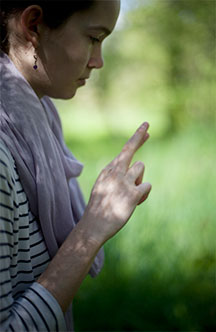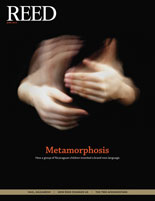
IRIS login | Reed College home Volume 92, No. 2: June 2013
Birth of a Language

Photos by Eric Rose
How a group of Nicaraguan children invented a new language and what it tells us about the nature of the human mind.
By Chris Lydgate ’90
Her hands pirouette through the air like miniature ballerinas. There is no hesitation, no break in the rhythm, as she pokes an invisible ogre with an imaginary knitting needle or slices an ethereal loaf of bread. Her fingers fly far faster than the lumbering words that describe them. What is remarkable about this conversation is not the story the young woman is telling, but the way she is telling it. She is using one of the world’s youngest known languages—Nicaraguan Sign Language, also known as Idioma de Señas de Nicaragua, or ISN.
No one knows exactly how many people use ISN as their primary means of communication; the total is probably less than a thousand. But for linguists, ISN has profound implications. Emerging unexpectedly from Managua in the 1980s, it represents one of the few times that scholars have been able to witness the birth of a completely new language. ISN also provides an unparalleled opportunity to test one of the most controversial theories in linguistics, explore the forces that shape human language, and shed light on a philosophical debate that goes back to Descartes. All of which is elegantly captured in the senior thesis of linguistics major Katelyn Best ’13.
![]()
For most of the last century, most of Nicaragua’s deaf people lived in profound linguistic isolation. With little or no contact with other deaf people, they used rudimentary gestures known as “home signs” to communicate with their families, but these gestures were of little value outside the deaf person’s immediate circle.
In 1977, the government of Nicaragua established that nation’s first school for deaf children in the capital, Managua. Four years later, following the overthrow of the Somoza government, the Communist regime set up a second, larger school for the deaf designed to help its students learn vocational skills.
The school’s initial approach was to teach its students to lip-read Spanish and to use American Sign Language to spell individual words. After several years, however, two things became clear. First, the classes weren’t very effective—the students weren’t interested in lip-reading. Second, the students were using their own system of gestures to communicate in the playground, on the bus, and in the classroom (especially when the teacher’s back was turned). Trouble was, none of the teachers could understand them.
In 1986, the Nicaraguan Ministry of Education hired an American sign language expert, linguist Judy Kegl, to figure out what was going on. What she discovered was astonishing.
“When I noticed that the younger the child, the more fluent they were signing, it reminded me of the rebirth of Hebrew, where a dead language was brought back to life by teaching it to children and letting their brains do the rest,” says Kegl, now professor and director of the signed language research lab at the University of Southern Maine. “Here, the children’s brains were taking in the raw material of gestural input and via the acquisition process creating a new language.”
Kegl was witnessing a profound moment. Unbeknownst to their teachers, the children were developing a method of communication that was far more sophisticated than a pantomime collection of gestures. They found ways to convey complex abstractions and make critical distinctions in time, space, mood, and aspect—all without having known any other language. They were, in other words, creating a language out of thin air.
![]()
Linguists categorize languages according to their ancestry. The Romance languages (such as French, Italian, Portuguese, Romanian, and Spanish) descend from Latin. The Polynesian languages (such as Hawaiian, Samoan, Tongan, and Maori) share a lineage that can be traced back, linguists believe, to Taiwan. Readers of a certain age may remember the grand branching language diagrams that used to adorn the inside covers of dictionaries. As you move up the tree, the names of the language families grow increasingly august—Indo-European, Niger-Congo, Dravidian, Sino-Tibetan, Afro-Asiatic, and so on. And at the very top, there lies a question mark—do the trunks converge? Was there, as the Book of Genesis suggests, a single great-grandmother tongue, now lost to the millennia, that gave rise to all the spoken languages of the world? If so, what did it sound like—and how was it transformed into languages as different as Cornish and Kxoe?
These questions are still hotly debated by linguists. But while specific genealogies can be hard to untangle (is Scots a dialect of English or a variant of Gaelic with English influence?), it’s fair to say that virtually all languages are related to, and derived from, older languages.
That’s not the case with ISN, however. Although it uses the ASL system for fingerspelling and has borrowed some vocabulary, the two languages are not genetically related. The fact that ISN has no real linguistic ancestors makes it an ideal testing ground to examine questions about the structure of language, says Katelyn.
It’s an overcast March afternoon, and we’re sitting in the Paradox Café. Katelyn is perched in a chair sporting a white sweater, a plaid skirt, green Nike sneakers, and a Mickey Mouse watch. She grew up in Eugene and went to a French immersion school. She visited Reed during her senior year in high school and was instantly smitten. “I knew I wanted to be here.”
She packed a lot into her four years on campus. She played the cello in the orchestra, wrote for the Quest, worked with the canyon crew, and rode horses for PE—she enjoyed riding so much that she worked at the stables in return for lessons. But it was an introductory course with Matt Pearson ’92 [linguistics 2001–] that awakened her to the joys of linguistics. “It was really fun, looking for patterns in languages to see how they’re related,” she says.
The following semester, she took a course in so-called “contact languages” with Kara Becker [linguistics 2010–] and studied pidgins—trade languages which arise when two or more groups need to communicate but have no language in common. Pidgins typically have impoverished vocabularies, stripped-down grammar, and low prestige. They are almost always second languages, spoken because the primary languages are mutually unintelligible.
After a couple of generations, however, the children of pidgin-speakers confront a dilemma. They have limited access to their parents’ primary language—in fact, pidgin may be the only language they have ever really used. So they make it better. They develop, refine, and extend the pidgin into a creole—a highly structured language capable of expressing the full range of human thought. Creoles are spoken throughout the world, particularly in places with a legacy of colonialism and slavery, such as Jamaica, Haiti, Papua New Guinea, Hawaii, Suriname, and so on. They typically draw their lexicon from the dominant, or superstrate language, but their grammatical structure is often completely different. For example, take this statement in Guyanese Creole:
She mosi de bad mek she tek he.
(“She could only have married him because she was completely broke.”)
Or this one:
Mi mind gi’ me se me de mek me de.
[My mind gives me that I exist] causes [(the fact that) I exist]
(“I think therefore I am.”)
A conversation in Nicaraguan Sign Language
In the 1980s, a British linguist named Derek Bickerton noticed some striking similarities between Sranan, a creole spoken in Suriname, and Hawaiian Creole. Although the two languages had radically different origins, they both demonstrated linguistic properties that had nothing to do with English. And it wasn’t just the creoles of Suriname and Hawaii that were similar—many creoles, including those based on French and Arabic, showed similar characteristics.
Several theories had been proposed to account for this unlikely phenomenon. One theory held that 17th-century sailors spoke a sort of nautical jargon that was adopted around the world. Another proposed that a protocreole arose in Portuguese colonies in West Africa and subsequently migrated. A third was that substrate languages from Africa were responsible for the creoles’ similarities.
Bickerton proposed something much more radical. Cast upon a rocky linguistic shore, deprived of a fully expressive language of their own, the children of pidgin speakers drew upon an innate faculty—the language bioprogram—to build a new language from within. This program favors certain grammatical features, such as putting subjects before objects. The reason that creoles are so similar, in other words, is that the human mind is preprogrammed to construct language in a certain way—and creoles offer a peek into that ideal structure.
Bickerton’s hypothesis echoes Noam Chomsky’s theory of “deep grammar” and touches on a philosophical debate that has been raging since the 17th century. Do we acquire our ideas from sensation and experience? Or are we born with certain ideas built into our minds? Hume argued that our ideas come from perceptions—how could you have the idea of the color red if you had never seen the color red? Descartes proposed that some ideas, such as God, must be innate, because nothing in our experience corresponds to them.
Katelyn first encountered the Bickerton hypothesis in Becker’s class. “I found it very appealing,” she says. “We know that language acquisition happens but the mechanism is a mystery. Bickerton’s hypothesis that creoles are the closest thing to the original human language—that really intrigued me.”
She was also struck by its shortcomings—many scholars have picked on Bickerton’s definition of creoles or pointed out that not all creoles demonstrate the features he predicted. Much of the debate has centered on the influence of the dominant, or superstrate language, which tends to obscure the mechanism of the bioprogram.
Later in the course, she read a 1996 paper by Kegl and McWhorter in which the authors tossed out the casual suggestion that ISN would be an ideal candidate for exploring Bickerton’s hypothesis. Suddenly, she knew she had found the perfect thesis topic—to test Bickerton on a language with no ancestors at all.


LATEST COMMENTS
steve-jobs-1976 I knew Steve Jobs when he was on the second floor of Quincy. (Fall...
Utnapishtim - 2 weeks ago
Prof. Mason Drukman [political science 1964–70] This is gold, pure gold. God bless, Prof. Drukman.
puredog - 1 month ago
virginia-davis-1965 Such a good friend & compatriot in the day of Satyricon...
czarchasm - 4 months ago
John Peara Baba 1990 John died of a broken heart from losing his mom and then his...
kodachrome - 7 months ago
Carol Sawyer 1962 Who wrote this obit? I'm writing something about Carol Sawyer...
MsLaurie Pepper - 8 months ago
William W. Wissman MAT 1969 ...and THREE sisters. Sabra, the oldest, Mary, the middle, and...
riclf - 10 months ago